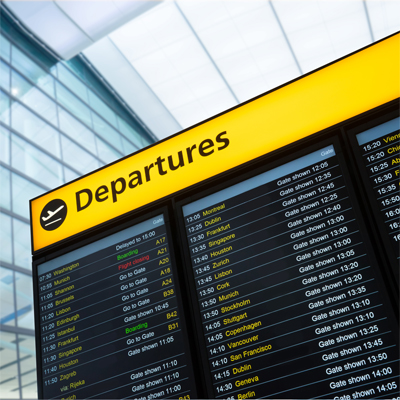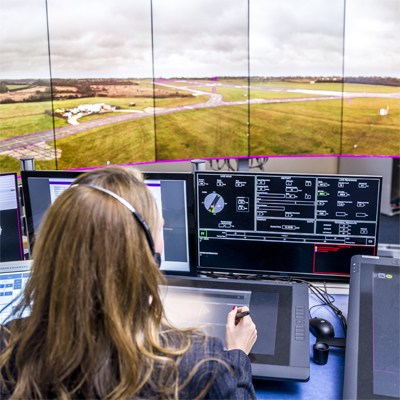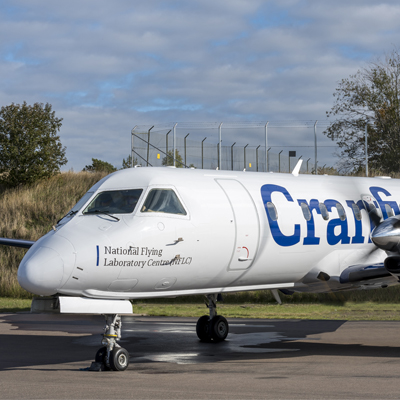So far in our five-part ‘future of flight’ series, we’ve looked at possible innovations in aircraft technologies and the changes to how we manage our airspace that would be required to implement these technologies. But how might airports, and our journey from door to destination, change to be more efficient and allow a seamless integration of modes of transport?
Airports: making journeys more seamless
Increasing urban air mobility, de-stressing travel and making the journey from door to destination more efficient – and more seamless – were key topics among panel members during our future of aerospace webinar in December 2020.
Dr David Paisley (PhD Aerodynamics 1982), Technical Fellow/Product Development, Boeing, discussed the need to de-stress travel, looking at the airport experience to provide security without compromising passenger time and convenience. Cranfield’s new Digital Aviation Research and Technology Centre (DARTeC), the construction of which is nearing completion, aims to address some of the key research challenges facing aviation – including increasing the efficiency of our airports. Researchers are working to establish how digital technologies can be integrated to transform airport operations – from passenger experience to aircraft turnaround and cargo/baggage journeys. Concepts will be explored such as extended, virtual and augmented reality, artificial intelligence, automatic, digital twins and internet of things – making use of facilities including an at-scale passenger experience laboratory, operational aircraft stand and a fully configurable aircraft cabin interior.
To celebrate the upcoming opening of DARTeC, Cranfield is hosting a digital aviation conference in April, bringing the digital aviation community together to address industry challenges with a theme of ‘towards a sustainable future’. Watch the video to learn more.
Intermodal transport solutions
David also touched upon the fact that all of our journeys are intermodal – with passengers often using several different modes of transport as part of their journey. Therefore, we need to make these journeys more seamless and we need to ensure that different modes of transport aren’t needlessly competing against each other, instead looking at the whole transport infrastructure. At Cranfield, the Multi User Environment for Autonomous Vehicle Innovation (MUEAVI) – an instrumented transport corridor through the middle of the campus – provides a purpose-built experimental facility for the rapid development of on- and off-highway, ground and airborne autonomous solutions. This includes vehicles, infrastructure, data, logistics, environment, sensors and their implementation and management. Providing the opportunity to experiment and accelerate such transport solutions could help to develop the seamless, integrated door, to airport, to destination experience Dr Paisley mentioned.
Another part of making our journeys more seamless is bringing flight closer to home – reducing the all-too-common one to two hour plus journeys most of us face to travel to major airports – something that the adoption of new urban air mobility technologies could address.
Enhancing urban air mobility offers an exciting new market within the aviation industry. Chana Sais (MSc Thermal Power 2018), PhD researcher at Cranfield’s Propulsion Engineering Centre, described it as a promising way to ease congestion in urban areas and increase travel flexibility. Chana outlined that the urban air mobility industry is expected to reach a market value of $15.2 billion by 2030, with unique aircraft architectures being proposed by industry and academia.
Urban air mobility challenges
The key technology development challenges we face in enhancing urban air mobility capabilities according to Chana, include:
- Battery-specific energy – limited in specific energy, advancements in the technology could allow fully-electric flights in the future.
- Thermal management systems.
- Flight controls/on-board systems – advancements would enable the potential to fly in fully-autonomous vehicles in the near future.
- Power management strategies.
Key areas to focus on to enable new applications to be implemented include:
- Infrastructure/air traffic management.
- Take-off and landing zones.
- Re-charging and storage facilities for new applications.
- Robust air traffic management.
- Integration with other modes of transport.
It’s clear that, in order to improve the airport experience and expand urban air mobility capabilities, innovation will be required across the board.
Don’t forget to catch up on the previous articles in our future of flight series - covering aircraft and airspace – and keep an eye out for the next article, discussing airlines, sustainable fuels and the rate of adoption of new technology.
Interested in learning more? Visit the alumni portal to watch a recording of the ‘Reimagining our aerospace sector in 25 years’ time’ webinar in full. You can also learn more about the aerospace facilities and capabilities at Cranfield by downloading the brochure.





